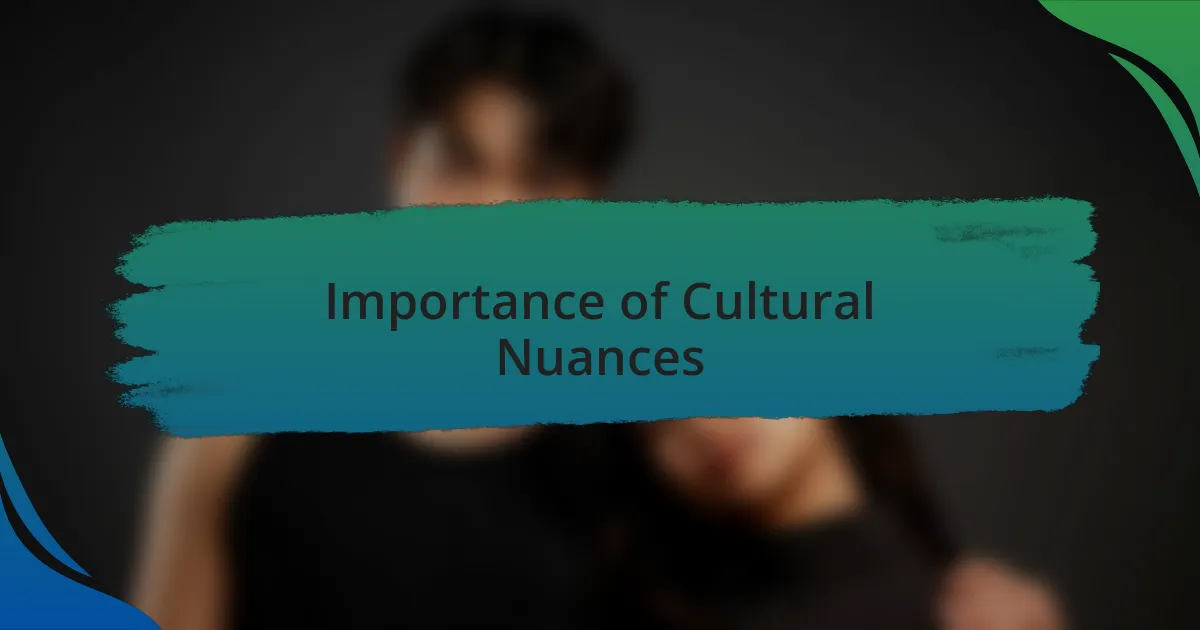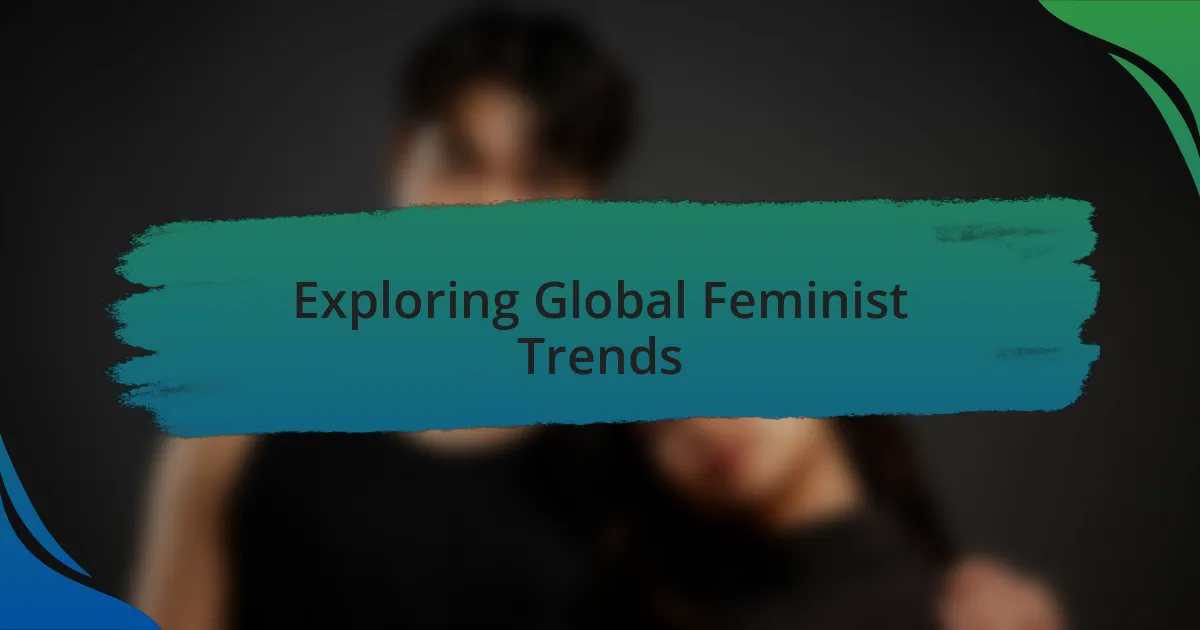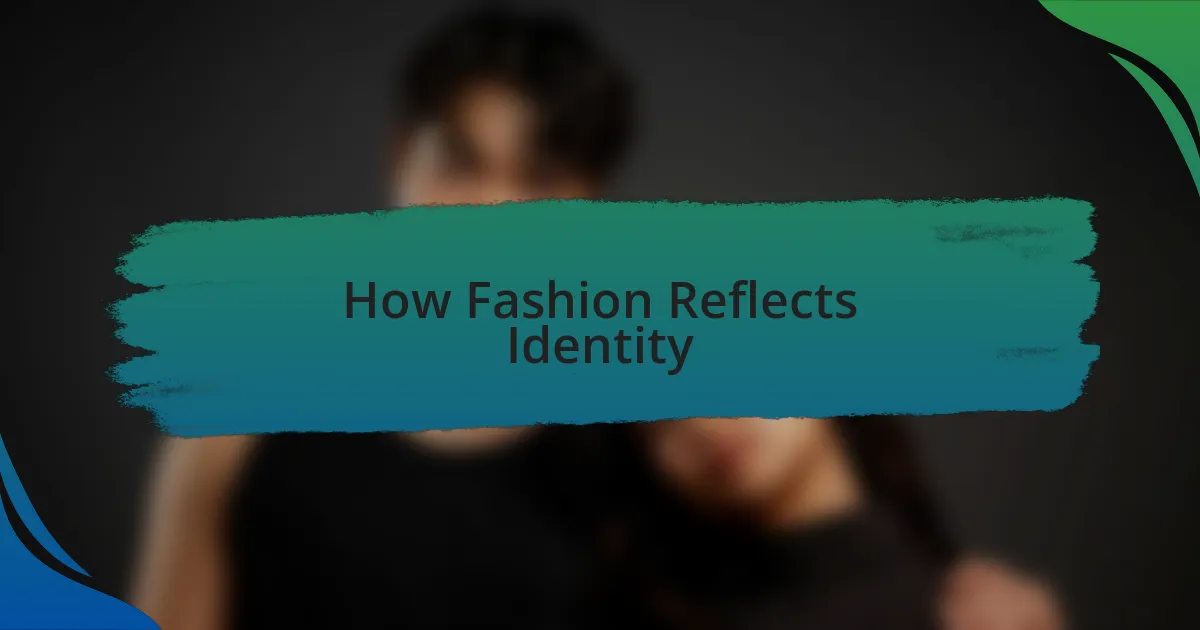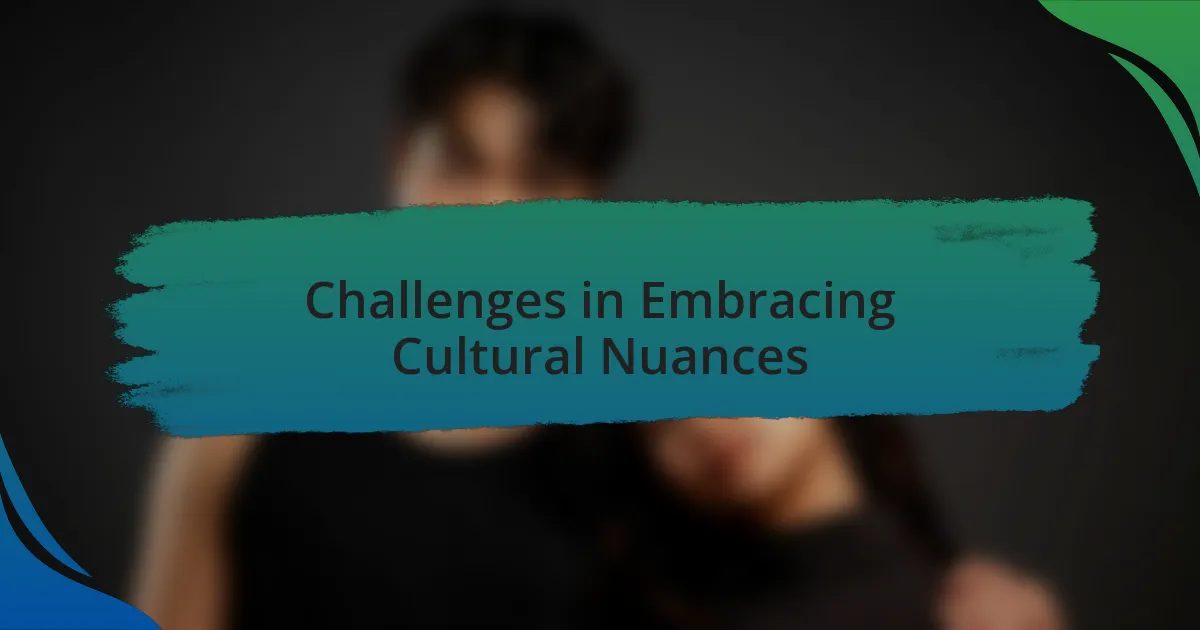Key takeaways:
- Feminist fashion serves as a powerful form of expression that challenges societal norms and reclaims women’s identities.
- Cultural nuances play a crucial role in understanding feminist fashion, as they reflect the diverse experiences and backgrounds of women worldwide.
- Fashion can act as activism, connecting personal style with broader social movements and fostering solidarity and empowerment.
- Engaging with cultural elements in fashion requires awareness and respect to avoid appropriation and to honor the stories behind the clothing.

Understanding Feminist Fashion
Feminist fashion is more than just clothing; it’s a form of expression that celebrates autonomy and challenges societal norms. I remember attending a local art exhibit showcasing female designers who used their pieces to share stories of empowerment. It struck me how each garment captivated the essence of resistance and resilience, making me wonder: Can clothing really amplify voices in the fight for gender equity?
At its core, feminist fashion reclaims identity, pushing back against the commercialization of women’s styles. I’ve often pondered how often we see fashion dictated by others—mainstream media especially. But when I wear a piece designed by a female artisan or choose sustainable options that align with feminist values, I feel empowered, as if I’m part of a movement rather than just a trend. How can we all contribute to this narrative shift in a world that often sidelines feminine voices?
Moreover, understanding feminist fashion invites reflection on inclusivity and diversity within the movement. I recall a poignant moment at a fashion panel where attendees discussed how different cultural backgrounds influence our perception of empowerment through style. This notion resonated with me deeply, sparking questions about how my own cultural influences might shape my fashion choices. How does your cultural background inform your perspectives on fashion?

Importance of Cultural Nuances
Cultural nuances are vital in understanding feminist fashion because they shed light on the diverse experiences of women around the world. I vividly recall a conversation with a friend from Morocco who explained how traditional attire is a blend of history and modern expression. Hearing her describe the intricate patterns and meanings behind her clothing made me realize how cultural elements can redefine empowerment and challenge stereotypes. Have you ever considered how your own cultural background informs your clothing choices?
Diving deeper into the significance of cultural nuances, I think about my travels and the garments I’ve encountered, each with its own story. For instance, when I visited Japan, I was struck by the elegance of a kimono—its beauty lies in both the fabric and its cultural heritage. This made me appreciate how feminist fashion isn’t just about personal expression; it’s also about honoring the stories embedded within cultural symbols. Isn’t it fascinating how a single piece of clothing can connect us to history and to each other?
Moreover, acknowledging these nuances encourages a richer dialogue about representation in the fashion industry. I remember attending a fashion show where models showcased garments inspired by various cultures. It was empowering to see how these designs celebrated diversity rather than appropriating it. This experience left me wondering: How can we foster respectful exchanges that elevate voices from different backgrounds in the fashion conversation?

Exploring Global Feminist Trends
Exploring global feminist trends reveals a tapestry of voices and influences that shape the way women express themselves through fashion. When I attended a panel discussion featuring designers from different countries, I was captivated by how each one articulated the significance of their work in advocating for women’s rights. One designer from Brazil shared how her vibrant creations were born from both personal struggle and cultural celebration, making me reflect on the role that fashion can play not just as art, but as activism. Can fashion really serve as a bridge for social change?
As I delved into the world of African fashion, I was particularly moved by the stories woven into the fabrics. It struck me during a visit to a local market in Accra, where I encountered a vendor wearing a colorful kente cloth. She spoke passionately about exporting her designs to empower women in her community economically. In that moment, I felt the powerful connection between garment and ideology, reinforcing my belief that feminist fashion thrives on collaboration and empowerment. Don’t you think it’s inspiring when fashion transcends aesthetic and becomes a platform for solidarity?
Furthermore, the rise of sustainable fashion in feminist movements across Europe has left a lasting impression on me. At an eco-friendly fashion fair in Berlin, I saw firsthand how makers integrate environmental stewardship with social justice, creating pieces that are both beautiful and meaningful. This approach reshapes our understanding of consumerism, prompting us to consider: How can we align our fashion choices with our values? Through these global lenses, the intersection of culture and feminism in fashion truly invites us to rethink our role as consumers and advocates.

How Fashion Reflects Identity
Fashion is often a direct reflection of identity, serving as a canvas for individuals to showcase their cultural background and personal beliefs. I remember once attending a street style event where each outfit told a story. It made me realize that the way we dress can express not only our personality but also our roots, values, and experiences. What does your outfit say about you?
In my travels, I’ve seen how different communities use fashion to navigate societal norms and express their resistance. Like during an art show in Morocco, where local women displayed their attire adorned with symbols of empowerment. Each piece sparked a conversation, reinforcing the idea that clothing can be more than mere fabric; it embodies a collective struggle and a celebration of heritage. Have you ever worn something that resonated on a deeper level?
Moreover, as I engaged with various cultural groups, I found that fashion often acts as a mirror reflecting societal changes. It was during a volunteer event in a women’s shelter that I observed how a simple garment could restore dignity and convey strength. Witnessing these women embrace their style reminded me that our clothing choices can be powerful declarations of identity. Isn’t it fascinating how an item of clothing can carry such immense significance?

My Personal Fashion Experiences
One experience that stands out is when I attended a cultural festival that celebrated women’s contributions to fashion. I remember being captivated by a local designer’s collection, which beautifully integrated traditional elements with contemporary designs. It got me thinking—how does one balance the richness of heritage with the desire for modern expression? For me, that event was a revelation; it highlighted the transformative power of fashion to bridge generational gaps.
Another memorable moment was my first visit to a tailor in a bustling market overseas, where I was eager to have a dress made that reflected both my personal style and adopted cultural elements. As we selected fabrics and discussed patterns, I felt an incredible connection to the craft and the community behind it. The joy of seeing my ideas come to life, along with the warmth of the tailor’s smile, made me realize how fashion can foster connections—not just between us and our clothing, but also with the people who create it.
Recently, I joined a discussion group focused on sustainable fashion that included voices from various cultural backgrounds. I was moved by how participants spoke passionately about their fashion choices, linking them to activism and environmental awareness. Listening to their stories, I thought about my own wardrobe choices—how often do I consider the broader implications of what I wear? This experience deeply resonated with me, emphasizing that fashion is not merely about aesthetics, but also about values and responsibilities.

Challenges in Embracing Cultural Nuances
Embracing cultural nuances in fashion isn’t always easy. I recall an experience where I attempted to incorporate elements from a culture I admired into my daily attire. Initially, I felt a sense of pride, but then doubts crept in—was I honoring the culture, or was I merely appropriating it? This kind of internal conflict is common when navigating fashion rooted in cultural heritage.
Cultural misunderstandings can arise when we don’t fully grasp the significance behind traditional garments. I remember slipping into a beautifully embroidered Kaftan at a friend’s wedding, thinking it was simply stylish. Later, I learned that the symbolism woven into the fabric conveyed deep historical meaning, and I questioned whether I had worn it carelessly. It made me reflect on how essential it is to educate ourselves about the stories clothing tells.
Another challenge I faced revolved around feedback from others when experimenting with cultural styles. I wore a fusion outfit to a gathering, only to hear mixed reactions. Some praised my courage, while others felt it missed the mark. It made me ponder—how do we find the balance between personal expression and cultural respect? In navigating these challenges, I discovered that open dialogue is essential. It reminds me that fashion is as much about conversations as it is about clothing.

Lessons Learned Through My Journey
Throughout my journey, I’ve learned that being culturally aware in fashion requires humility and a willingness to listen. I vividly remember attending a fashion workshop where participants wore their favorite ethnic pieces. One person shared how their grandmother’s sari was intricately tied to their identity. This moment struck me—it’s not just about wearing something beautiful; it’s about recognizing the stories and histories that fashion encapsulates. Have you ever stopped to consider whose voices are being uplifted when you choose your wardrobe?
Additionally, I realized that there’s a fine line between inspiration and imitation. I once designed a piece inspired by colorful patterns from Indigenous textiles, eager to showcase its aesthetic value. However, I later questioned whether I had truly appreciated the cultural significance behind those patterns or if I had merely reduced them to a design element. This self-reflection opened my eyes to the importance of honoring the origins of the styles we embrace. It made me wonder: are our creative expressions genuinely respectful, or are they at risk of becoming superficial?
One of the most profound lessons has been understanding the impact of my choices on the broader community. After sharing a blog post on cultural fashion, I received an outpouring of responses—some heartfelt, while others were critical. A comment stood out, expressing how cultural representation felt diluted when approached carelessly. This feedback taught me that fashion can be a platform for empowerment, but it comes with responsibility. How can we ensure our fashion choices contribute positively to cultural conversations? This remains a question I ponder regularly as I navigate my evolving journey in feminist fashion.